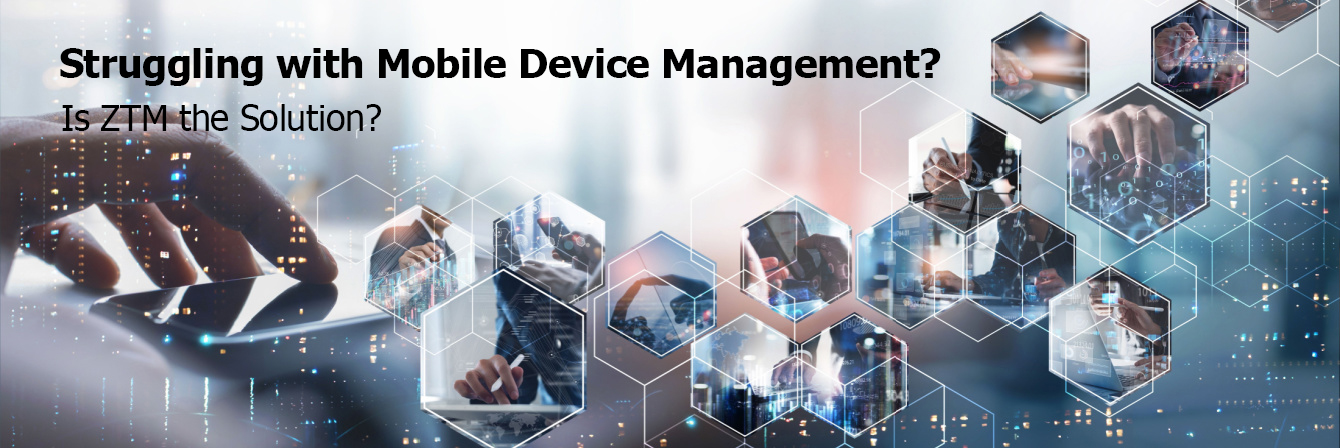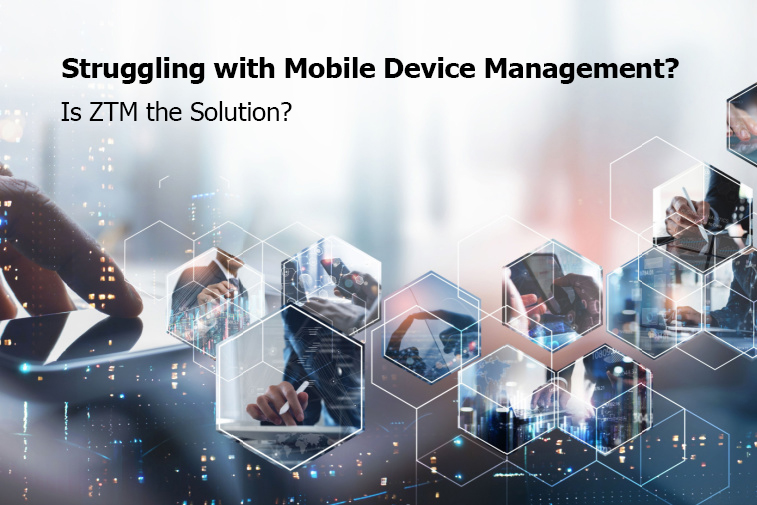
Today, companies use more mobile devices in the workplace than ever before. Meanwhile, the complexity of managing a corporate mobile fleet is also increasing. Though this technology helps improve productivity and operational efficiency, the deployment, setup and management processes often slow down IT administrators and end users. From enrolling and configuring each new device individually to analyzing its usage and performance, these manual processes create inefficiencies that make managing multiple devices exceedingly difficult.
That’s where zero touch comes in.
With a zero touch management model, IT teams can automate and optimize the end-to-end lifecycle of corporate devices. But what exactly does this approach entail, and is it right for your organization? To find out, we’ll take a closer look at what zero touch management is and the challenges it solves.
What Is a Zero Touch Device Management Model?
A zero touch management model means IT admins can deploy ready-to-use corporate-owned devices to employees without ever having to physically handle or provision them. How does this work? Using a centralized zero touch console, IT admins can remotely order, configure, deploy, enroll and manage their entire device fleet with minimal effort. They can also automate these configuration processes to eliminate the need for manual work, enabling faster deployment without the need for human intervention.
Why Use a Zero Touch Approach?
As the number of corporate devices grows exponentially, organizations are simply unable to handle the increasing complexity. At the same time, most legacy management systems require manual device configuration.
With a zero touch portal, IT teams have a single location to automate enterprise configuration, deploy mobile devices and manage all of it remotely. This simplifies things for both admins and end-users, enabling your organization to streamline mobility operations and device setup before it impacts employees and services.
Implementing End-to-End Zero Touch Management
A zero touch management model can be broken down into three major processes: provisioning, enrollment, and lifecycle management:
1. Zero Touch Provisioning automates the setup and device configuration processes before they are deployed to end users. This involves adjusting the default configuration to match enterprise settings and security policies.
2. Zero Touch Enrollment focuses on automating the enrollment process, registering corporate mobile devices with the company’s EMM solution to enable remote management. This eliminates the need for manual intervention on the part of IT teams and device users.
3. Zero Touch Lifecycle Management encompasses the end-to-end device lifecycle to streamline ongoing maintenance, management and updates. It also includes analytics to monitor device health and utilization.
With a centralized zero touch console, IT admins can simplify and streamline end-to-end mobility management, achieving greater efficiency, control and visibility.
Challenges in Mobility Management
Zero touch automation is a relatively new and increasingly popular approach to mobile device management. Prior to adopting this model, IT admins faced numerous challenges managing the end-to-end device lifecycle — from time-consuming manual processes to dealing with fragmented tools and siloed data. So, how does touch-free management solve these issues?
Let’s explore some of the most common and pressing challenges IT managers deal with, and examine how a zero touch solution can help.
1. Accelerating the Deployment Process
The first and most obvious challenge is one we’ve already touched on, but it bears repeating: IT teams need a faster deployment process.
In traditional mobile management, IT admins are responsible for manually provisioning and configuring each device — a time-consuming and error-prone process. As a result, organizations often struggle to deploy devices quickly and effectively enough to support their workforce.
With zero touch configuration, admins can automate these tasks, minimizing human errors while enabling faster deployment.
2. Simplifying Device Management
Efficient device management is crucial, especially as IT teams must handle large fleets of corporate devices. However, organizations often use a disparate patchwork of systems, tools, applications and even manual processes to manage the end-to-end lifecycle, leading to swivel chair activities and added complexity.
In addition to automating device provisioning tasks, a zero touch console can centralize management systems and data sources on a single platform. With easy access to the tools and information they need in one place, IT admins can simplify and streamline their mobility workflows.
3. Saving Time and Resources
From updating software and troubleshooting device issues to dealing with complex legacy customizations and more, IT teams often face enormous workloads. Moreover, many of these tasks are tedious and repetitive, draining valuable time and resources that could be better utilized elsewhere.
Zero touch devices offer self-service capabilities like enrollment/unenrollment, remote data wiping and repair support. That way, device users can execute these actions themselves, freeing up IT time and resources for high-value tasks.
4. Managing IT Costs
Manually deploying, managing and monitoring corporate mobile devices throughout their entire lifecycle is often incredibly expensive. Without effective cost management, these IT operations can quickly add up — not to mention the costs of procurement and maintenance.
Beyond the value of eliminating inefficient manual support tasks with automation and self-service features, zero touch management can help save on IT costs by implementing lifecycle management strategies. With real-time reports and analytics on individual device usage, admins can optimize utilization across the entire fleet to further save on maintenance and repair costs.
5. Reducing Downtime
Unplanned downtime due to device failures can cost companies as much as $300,000 per hour, according to ITIC. Not only is an incident incredibly expensive, but it also disrupts business operations, reduces productivity and potentially impacts customers.
Zero touch management enables automated device monitoring to minimize the frequency and duration of downtime events. Using real-time health and utilization metrics, along with proactive maintenance processes, IT admins can remotely identify and resolve issues before they result in device failure — all within a zero touch console.
6. Ensuring Cybersecurity
While implementing new technologies and devices can help organizations stay competitive, they can also introduce new security vulnerabilities, especially when a device is lost or stolen. At the same time, cyberthreats are constantly growing and evolving, and a single data breach costs an average of $4.35 million.
Zero touch management addresses these risks by allowing IT admins or device users to remotely lock the device until it can be recovered. They simply use the portal to report it lost or stolen and the device becomes instantly unusable without a passcode. If they’re unable to recover it, they can instantly wipe its data and factory reset the device to avoid a potential data leak.
7. Improving the User Experience
Device users expect a seamless and intuitive mobile experience that can enhance their productivity at work. Often, this starts during the onboarding process, when a new employee receives their corporate-owned device, and ends when they leave the company and return the device. Manually enrolling and unenrolling each device takes far too much time, slowing down the process for end users.
A zero touch portal provides a single location for IT admins to perform bulk actions, allowing for efficient mass enrollment and unenrollment. Meanwhile, seamless integrations with the company’s EMM solution enable automated user profile assignments to synchronize with the active directory.
8. Scaling Mobility Management
As corporate mobile fleets continue to grow in size and complexity, it will only exacerbate all of these challenges. Rather than expanding mobility infrastructure, IT resources and budgets exponentially to keep up, organizations need a smart solution designed to efficiently handle modern mobile environments at scale.
Zero touch management solutions leverage hyperautomation to effortlessly deploy, manage and support mobile devices across their lifecycle. Not only does this simplify and accelerate mobility management, but it also improves scalability, allowing IT teams to support large-scale, ever-growing mobile environments.
Is Zero Touch Right For You?
If you relate to any of the challenges above, a zero touch management model is likely a good choice for your company. But which organizations benefit most from this type of touchless approach?
Zero touch is generally best suited for companies like managed service providers that struggle to handle increasingly complex mobile environments. These companies want the flexibility and agility to accelerate deployment, quickly adjust configurations and streamline lifecycle management — all while maintaining robust cybersecurity.
At the employee level, zero touch devices offer self-service features to save time and resources for IT administrators. For instance, if a high-touch mobile user loses their device, they can use the zero touch portal to start a workflow that immediately sends a replacement. Meanwhile, they can back up the data on the lost device, then instantly lock, wipe and factory reset it to avoid a potential data breach.
This seamless, automated workflow can minimize security risks and downtime, allowing your team to get back up and running the following or even the same day.
Zero Touch Mobility - Revolutionizing Mobile Device Management
Zero Touch Mobility from Samsung SDS is an innovative mobile management solution unlike anything else. Implement Zero Touch Mobility natively within your ServiceNow instance to act as a centralized control tower.
With end-to-end lifecycle management, you can automate device provisioning and Knox mobile enrollment to boost employee productivity and free up IT resources. Analytics and reporting dashboards provide real-time, in-depth insights into device utilization and performance, enabling proactive management and maintenance.
For more information on Samsung’s Zero Touch Mobility solution, click here or contact us today .
Contact Us to Schedule a Demo
- Workflow Hyperautomation in Mobility Lifecycle Management: Unleashing Efficiency
- How to Streamline Mobility Management With Zero Touch Deployment
- Four Big IT Transformations for Enterprise Agility
- Enhancing IT Asset Management With Zero Touch Mobility
- An Agile Approach, the Core of Corporate DT for Working Culture Innovation
